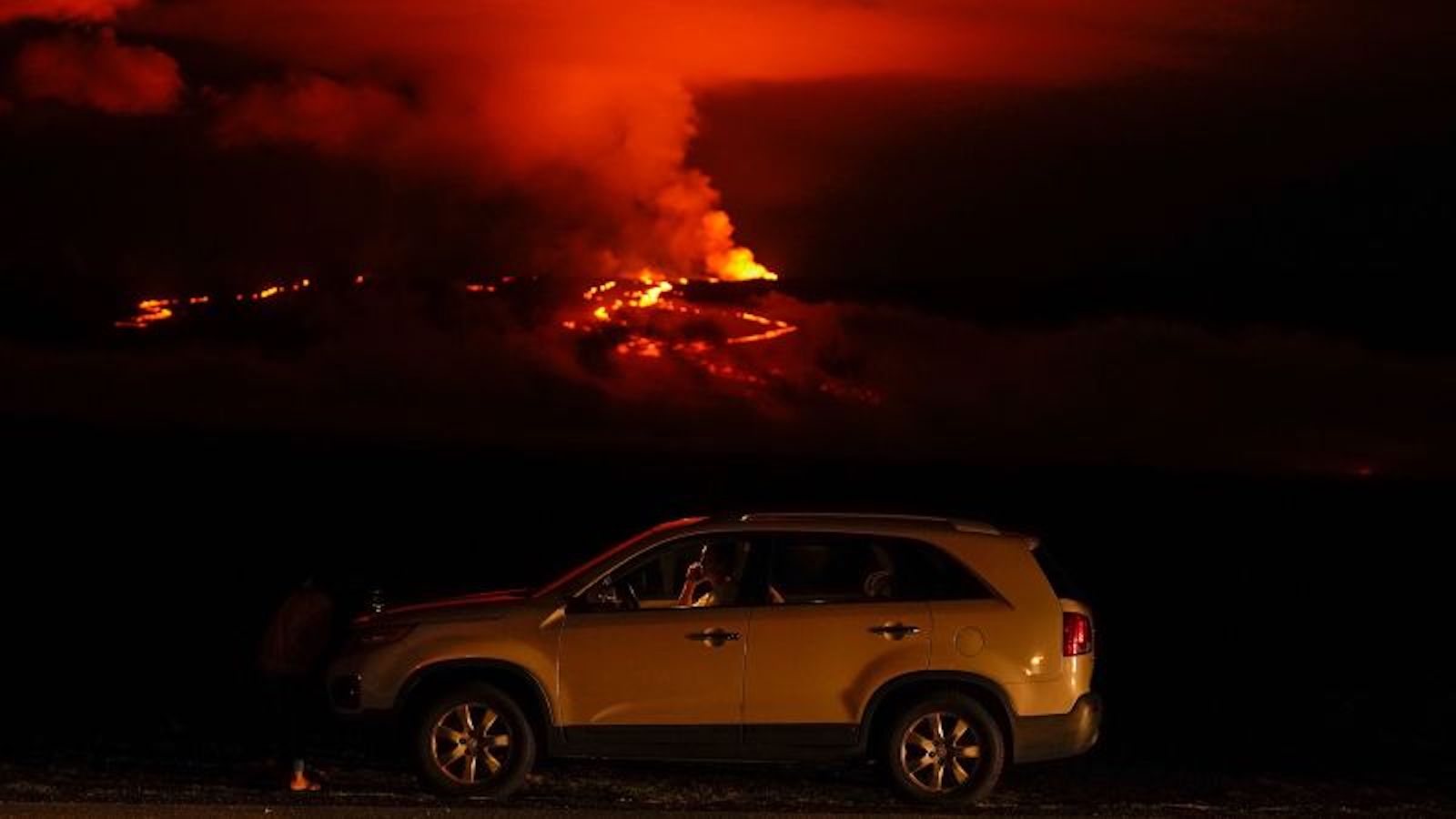(Trends Wide) — Officials in Hawaii have a message for the many people who flock to see the world’s largest active volcano ooze molten rock: They can do it, safely, from a newly developed route where they won’t receive fines.
Mauna Loa, on the Big Island of Hawaii, has been erupting for days, with lava shooting to heights of up to 45 meters this Tuesday.
And while the rare sight has kept officials and residents on guard against potential danger, local authorities have developed a way for visitors to literally view the eruptions.
A safety route from traffic hazards can now be accessed via Saddle Road, also known as the Daniel K. Inouye Highway, according to the Hawaii County Civil Defense Agency.
The one-way route “will provide a safe view of the lava flows,” the agency said Thursday, stating that parking on the highway was putting motorists at risk of traffic tickets and vehicles could be towed away.
The Dangers of Erupting Active Volcanoes in Hawaii
The eruption of Mauna Loa earlier this week – for the first time since 1984 – raised concerns related not only to the impact of lava on the island’s main highway, but also to health hazards from possible release of toxic gases into the air.
As of Thursday afternoon, the lava from Mauna Loa was just over 5 kilometers from Saddle Road, the fastest route linking the west and east shores of the Big Island, according to the US Geological Survey. But the lava flow rate has slowed and spread, sparing people and property from immediate threat.

A man talks on the phone in his car along Saddle Road as the Mauna Loa volcano erupts on November 30 near Hilo, Hawaii. (Credit: Gregory Bull/AP)
“Advance rates may be highly variable in the coming days and weeks due to the way lava is deposited on level ground,” the geological survey said in an update on Thursday.
Even so, the simultaneous eruptions of Mauna Loa and the neighboring Kilauea volcano, which has been erupting for more than a year, could put people at risk of inhaling contaminated air, state health officials have warned.
Residents and visitors can expect “vog conditions, air ash, and sulfur dioxide levels to increase and fluctuate in various areas of the state,” the Hawaii Department of Health said.
In addition, a combination of volcanic gas, fine ash and hair of pele, which are strands of volcanic glass, could be transported downwind, the geological study said.
And the columns of dark clouds coming out of volcanoes are not smoke, they are “volcanic gases, which are acid gases. You don’t want to breathe them in,” said volcanologist Jess Phoenix.
“You’re talking about hydrogen fluoride, hydrogen sulfide, carbon dioxide. These are all gases that are really not fun for the average person to breathe in, let alone if you have any sort of respiratory problem,” Phoenix said.
“Then, the Hawaiian Civil Defense Authority and the US Geological Survey will closely monitor volcanic smog…and inform affected communities well in advance if people with respiratory conditions need to stay indoors.”

A group of people stand on lava rock from a previous eruption near the Mauna Loa volcano as it erupts Wednesday near Hilo, Hawaii. (Credit: Gregory Bull/AP)
Children, the elderly and people with respiratory problems should reduce outdoor activities that cause heavy breathing and reduce exposure by staying indoors and closing windows and doors if volcanic gas conditions develop, said the DDepartment of Health.
While no evacuation orders have been issued, Hawaii Gov. David Ige said he signed an emergency proclamation as a “proactive” measure.
The governor acknowledged the potential for airborne hazards Wednesday, saying officials are monitoring air quality across the island.
“The concern is about dangerous gases from the fissures. And the most dangerous is sulfur dioxide,” Ige said. “The observation of the volcano must occur at a distance. It’s not safe to get close.”
Highway closure would cause major traffic headaches
It could take at least a week for lava from Mauna Loa to reach Saddle Road due to a significant reduction in lava flow velocity.
“The advance of the largest flow slowed down in the last 24 hours to a speed of around 0.04 km per hour,” the geological survey said Thursday. “However, there are many variables at play and both the direction and timing of the flow’s advance are fluid and expected to change over periods of hours to days.”
The state Department of Transportation and local officials have been working on a plan to close the highway if lava gets close enough to become dangerous, said Adam Weintraub, communication director for the Hawaii Emergency Management Agency.
But even with those plans in place, some drivers will still feel the burden of a much longer trip.
Emmanuel Carrasco Escalante, a landscaper, said he would then have to decide between the coastal highways on the north side or the south side to get from Hilo to Kona.
“It’s a hassle to drive all the way around the island,” he told Trends Wide. “If the road closes, that would add almost two hours, more gas and more miles, so I hope that [la lava] Don’t cross that road.”
The Department of Transportation shared a preliminary plan for the possibility of closure. The department can provide a six-hour notice of the road closure, Weintraub said.
“And staff at the Hawaiian Volcano Observatory say they can provide at least 24 to 48 hour advance warning if lava appears to be threatening the highway,” he said.
And if emergencies arise during a possible road closure, there are hospitals and first responders on each side of the island, Weintraub said.
— Trends Wide’s Hannah Sarisohn, Sara Smart, Holly Yan and Paradise Afshar contributed to this report.


:max_bytes(150000):strip_icc():focal(605x417:607x419)/Alabama-Woman-Forced-to-Attend-Jury-Duty-011725-tout-b-2583e44b563f4d4fbeec46beb0a5ee35.jpg)



